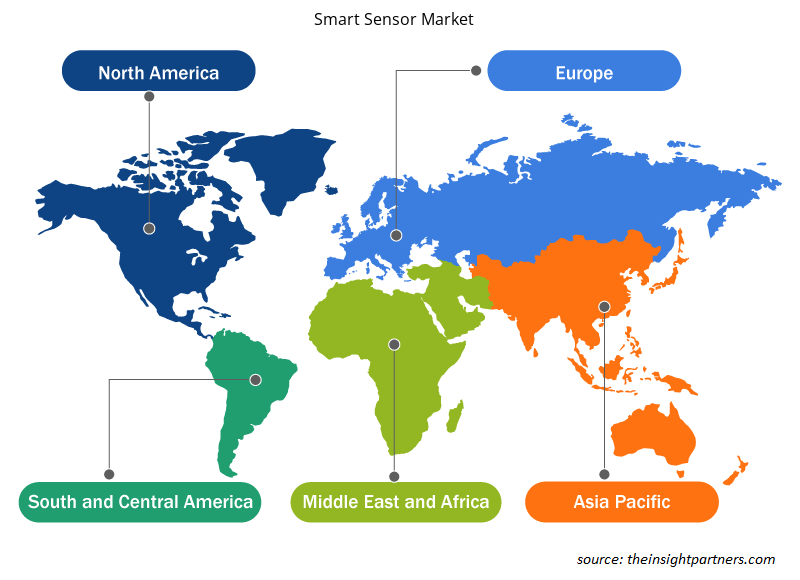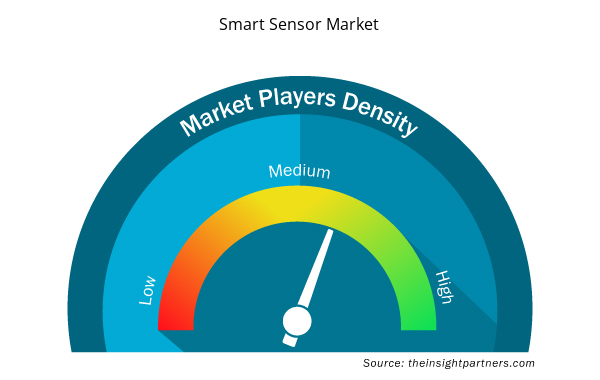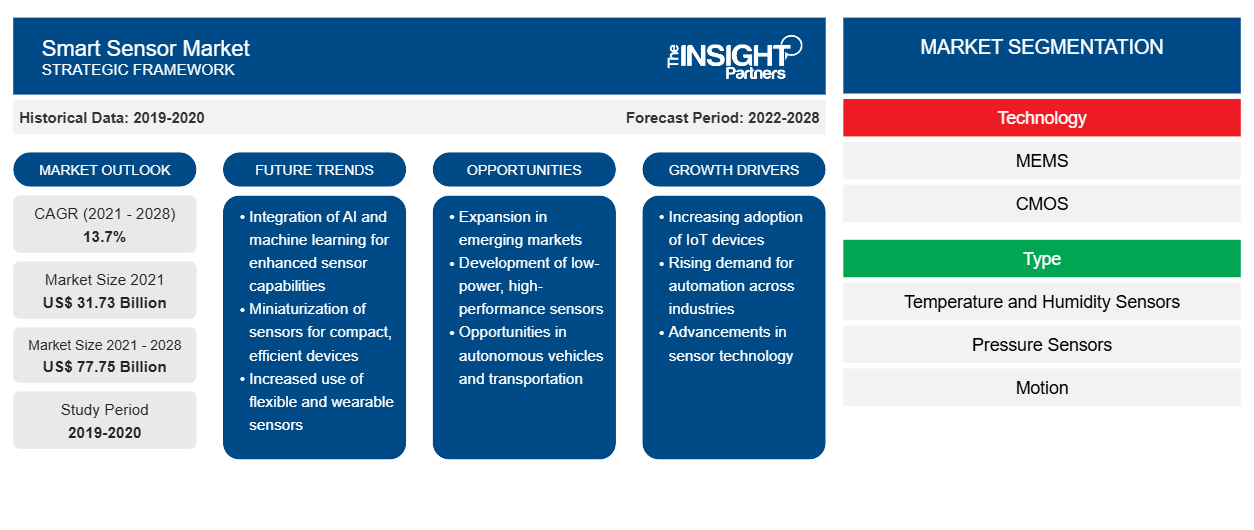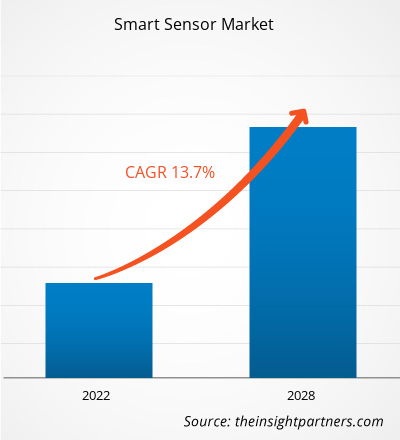智能传感器市场预计将从 2021 年的 317.311 亿美元增长到 2028 年的 777.476 亿美元。预计 2021 年至 2028 年期间的复合年增长率为 13.7%。
智能传感器比传统传感器更快、更准确。这些传感器比传统传感器更小、功耗更低。过去几年,智能传感器技术在基于物联网的设备和消费电子产品中的应用,以及在航空航天和国防、汽车、生物医学和医疗保健、工业自动化、楼宇自动化、消费电子、教育、机器人、农业和运输行业的应用引起了人们的极大兴趣。智能传感器在各种应用中的使用率增加是推动智能传感器市场规模的关键因素。
随着人们对安全和安保问题的日益关注,消费电子产品对智能传感器的需求也在不断增长,从而影响了智能传感器市场。家庭自动化中使用各种传感器,例如夜视红外传感器、声音传感器或麦克风和智能马桶。公司将各种功能(例如自动清洁、自动冲洗、水箱泄漏监控、溢水保护和健康监控)融入到智能传感器中。可以使用使用红外或运动传感器的自动系统来控制灯和风扇。
此外,随着生活方式和新现代生活水平的改变,对集成家庭自动化的模块化厨房的需求呈指数级增长,对智能传感器市场产生了积极影响。制造商正在开发基于合成传感器的设备来监测振动、厨房声音、光线、气体、温度、热量以及电磁温度和噪声,从而增加了智能传感器的市场规模。例如,Analog Devices, Inc. 提供 HMC1126 GaAs pHEMT 传感器。它是一种低噪声放大器,工作频率范围为 400 MHz-52 GHz,可用于微波无线电、甚小孔径终端 (VSAT)、测试设备和 5G 通信等多种应用。
定制此报告以满足您的需求
您可以免费定制任何报告,包括本报告的部分内容、国家级分析、Excel 数据包,以及为初创企业和大学提供优惠和折扣
- 获取此报告的关键市场趋势。这个免费样品将包括数据分析,从市场趋势到估计和预测。
智能传感器技术推动了智能手机和可穿戴设备的快速技术进步。汽车制造商越来越需要智能传感器来提高安全性和舒适性。使用无线技术来监控和控制配备智能传感器的安全设备正变得越来越普遍。在 COVID-19 期间,对支持智能传感器的可穿戴设备的需求激增、政府对绿色建筑建设的持续支持以及预测性维护为智能传感器市场参与者提供了丰厚的机会。
智能手机普及率的上升极大地推动了智能传感器市场的增长。智能传感器包括运动、位置、环境光、加速度计和陀螺仪等流行传感器。比吸收率 (SAR) 传感器可增强各种无线技术的连接性,例如智能手机、平板电脑和笔记本电脑中的 5G sub-6/4G/Wi-Fi。领先的半导体供应商 SEMTECH 提供 PerSeTM Connect、PerSe Connect Pro 和 PerSe Control 传感器,可用于智能手机、笔记本电脑、平板电脑和可穿戴设备等各种应用。
许多公司正在开发新的和先进的智能传感器,将微控制器组合在一个封装中。人工智能 (AI) 和物联网等现代技术使这种组合能够在小封装内实现。例如,Bosch Sensortec 的 BHA250 可以在 2.2 x 2.2 x 0.95 mm3 封装中结合 32 位微控制器和 14 位加速度传感器。此外,TE Connectivity 公司已将传感器与连接器集成在一起,以将功能封装在小空间中。智能传感器技术的这些发展对智能传感器市场的增长产生了积极影响。随着消费电子行业的增长,例如智能饮料自动售货机、智能家居自动化系统、简单计算机、数字助理(如 Alexa)和人类可穿戴设备,智能传感器市场对智能传感器的需求也在增加。随着消费者继续采用包括可穿戴设备、语音激活智能扬声器和智能家居设备在内的新兴产品,笔记本电脑、智能手机和电视等传统消费产品继续超出预期。
根据多项研究,未来几年将有数百亿台物联网设备连接到互联网,这将极大地影响智能传感器市场。随着城市政府适应新现实,COVID-19 正在推动城市复原力和数字化转型战略议程。
COVID-19 疫情对智能传感器市场的影响
COVID-19 的出现使人们更加关注利用数字基础设施进行远程患者监测的需求。由于目前病毒检测和疫苗的研发速度缓慢,人们已经确定更需要更强大的疾病检测和个人及人群健康监测,而可穿戴传感器可以提供帮助。虽然这项技术的实用性已用于将生理指标与日常生活和人类表现关联起来,但仍有必要将其应用于预测 COVID-19 的发生。
节能设备需求的不断增长推动了北美智能传感器市场对智能传感器的需求。由于不断变化的形势需要节能设备和产品,各公司正在转向节能的节能设备。此外,随着政府严格监管的解除,智能传感器市场对传感器的需求在各个行业都有所增加,这些监管在自动化行业中越来越受到关注。此外,汽车行业对传感器的需求也受到减轻汽车平均重量的愿望的推动。轻型汽车有助于提高燃油效率和能源优化。
智能传感器市场区域洞察
Insight Partners 的分析师已详细解释了预测期内影响智能传感器市场的区域趋势和因素。本节还讨论了北美、欧洲、亚太地区、中东和非洲以及南美和中美洲的智能传感器市场细分和地理位置。

- 获取智能传感器市场的区域特定数据
智能传感器市场报告范围
| 报告属性 | 细节 |
|---|---|
| 2021 年市场规模 | 317.3亿美元 |
| 2028 年市场规模 | 777.5亿美元 |
| 全球复合年增长率(2021 - 2028) | 13.7% |
| 史料 | 2019-2020 |
| 预测期 | 2022-2028 |
| 涵盖的领域 | 按技术分类
|
| 覆盖地区和国家 | 北美
|
| 市场领导者和主要公司简介 |
|
市场参与者密度:了解其对商业动态的影响
智能传感器市场正在快速增长,这得益于终端用户需求的不断增长,而这些需求又源于消费者偏好的不断变化、技术进步以及对产品优势的认识不断提高等因素。随着需求的增加,企业正在扩大其产品范围,进行创新以满足消费者的需求,并利用新兴趋势,从而进一步推动市场增长。
市场参与者密度是指在特定市场或行业内运营的企业或公司的分布情况。它表明相对于给定市场空间的规模或总市场价值,有多少竞争对手(市场参与者)存在于该市场空间中。
在智能传感器市场运营的主要公司有:
- ADI 公司
- 英飞凌科技公司
- 意法半导体
- TE Connectivity
- 微芯科技
免责声明:上面列出的公司没有按照任何特定顺序排列。

- 了解智能传感器市场顶级关键参与者概况
智能传感器市场细分
根据技术,智能传感器市场细分为 MEMS、CMOS 和其他。2021 年,MEMS 细分市场引领市场。根据类型,智能传感器市场细分为温度和湿度传感器、压力传感器、运动传感器、位置传感器和其他。2021 年,温度和湿度传感器细分市场占据最大市场份额。根据最终用途行业,智能传感器市场细分为消费电子、汽车、医疗保健、制造、零售和其他。
智能传感器市场的主要参与者包括 ADI 公司、英飞凌科技公司、意法半导体、TE Connectivity、Microchip Technologies、NXP Semiconductor、西门子股份公司、ABB 有限公司、罗伯特·博世有限公司和霍尼韦尔国际公司。除此之外,还分析了其他几家参与者,以了解全球智能传感器市场的整体动态。
- 历史分析(2 年)、基准年、预测(7 年)及复合年增长率
- PEST 和 SWOT 分析
- 市场规模价值/数量 - 全球、区域、国家
- 行业和竞争格局
- Excel 数据集


- Foot Orthotic Insoles Market
- Cut Flowers Market
- Virtual Production Market
- Ceramic Injection Molding Market
- Non-Emergency Medical Transportation Market
- Bioremediation Technology and Services Market
- Intradermal Injection Market
- High Speed Cable Market
- Semiconductor Metrology and Inspection Market
- Health Economics and Outcome Research (HEOR) Services Market

Report Coverage
Revenue forecast, Company Analysis, Industry landscape, Growth factors, and Trends

Segment Covered
This text is related
to segments covered.

Regional Scope
North America, Europe, Asia Pacific, Middle East & Africa, South & Central America

Country Scope
This text is related
to country scope.
常见问题
The Internet of Things (IoT) has accelerated the evolution of sensors to new heights. With the industry 4.0-powered cyber-physical transformation of manufacturing industries, many production facilities are taking up smart sensors. IoT platforms use a variety of sensors to deliver intelligence and data, allowing devices to function autonomously and the entire ecosystem to become more intelligent. Devices share information and improve their efficiency and functionality by combining a set of sensors and a communication network. The demand for IoT is growing in various industrial verticals, which, in turn, is supporting the growth of the smart sensor market.
In 2021, the market for temperature & humidity sensors held the largest market share. The demand for dependable, high-performance, low-cost sensors is growing, fueling the development of new technologies such as micro-and nanotechnology. Stick-on or printed sensors can be attached to equipment as labels to measure physical factors such as humidity, temperature, and gas pressure. Because of their inexpensive cost, compact size, and ease of use, the sensors are widely used in various sectors, including automobiles, homes, medical devices, the environment, food processing, and chemical. A temperature sensor's primary application is in a smart thermostat, a smart home device. Because of significant consumer interest, incremental technology breakthroughs, and increased accessibility, the total market for smart homes is expected to expand fast. Analog Devices, Inc., STMicroelectronics, TE Connectivity Corporation, Microchip Technology Inc., NXP Semiconductors, and other firms provide a wide range of temperature and humidity sensors to the global market.
MEMS is expected to dominate the smart sensor market during the forecast period. MEMS uses small miniaturized electromechanical and mechanical systems of actuators, sensors, and microelectronics. This technology is expected to continue to dominate the market for smart sensors in the coming years and to be the fastest-growing technology during the forecast period, owing to the numerous benefits it provides, including fast operations, high reliability, improved accuracy, easy maintenance, and replacement, and low energy and material consumption. This technology enables the sensor to perform intelligently by allowing them to store a significant quantity of data in the blink of an eye. The typical data obtained by the sensor is processed by the microprocessor, which erases or saves the data based on an advanced computation. The primary benefits of MEMS technology are reduced energy and material consumption, higher repeatability, increased accuracy, and increased sensitivity and selectivity. The MEMS segment is expected to have the most significant CAGR during the anticipated period. It is due to the increased use of IoT and wearable devices such as smartwatches. Smartwatches include tiny sensors, which contributes to an increase in the demand for MEMS technology for use in these devices. As a result, rising sales of smartwatches are likely to increase demand for MEMS technology throughout the forecasted period. Furthermore, the growing preference for smart homes would fuel the need for MEMS technology throughout the forecast period.
Many automotive manufacturers are coming up with new intelligent vehicles. They are more inclined toward cutting-edge smart sensors. APAC is expected to be the most important market for smart sensors vendors over the coming years in the automotive, infrastructure, consumer electronics, and pharmaceuticals industries, with China, India, and Japan demonstrating a significantly high demand. As the global manufacturing hub for various industries, including semiconductor and automotive, which produce home appliances, smartphones, computers, and peripheral devices, China's manufacturing sector has seen massive growth over the last few years. As a result, an enormous increase in the production and sale of sensing devices can be seen in this region. Long-range low-power wide-area network (LPWAN) technologies, such as NB-IoT, LoRa, LTE-M, and Sigfox, are fueling IoT vehicle connectivity innovation. LPWANs for IoT sensors allow low-power devices to wirelessly stream data packets over longer distances, as required in the automotive industry.
APAC dominated the smart sensor market in 2020. The APAC's vertical growth in the automotive, infrastructure, consumer electronics, and pharmaceuticals industries has positively impacted the smart sensor market. As the global manufacturing hub for various industries, such as semiconductor—which produces home appliances, smartphones, computers, and peripheral devices—and automotive, China's and India’s manufacturing sectors have seen massive growth. Consequently, an enormous increase in the sale and production of sensing devices can be seen in APAC. The growing population, low cost of smart sensors, the prominent existence of several manufacturing facilities, and rapid technological advancements in emerging markets are further contributing to the growth of the APAC smart sensor market.
Best-in-class sensors are highly secure and designed for indoor occupant analytics and energy savings, providing unprecedented precision in occupant detection, count, and movements and accurate reading of ambient lighting and motion sensing. These smart sensors can work as standalone devices or be integrated into other infrastructure appliances, such as thermostats or lighting fixtures, in keeping with the edge computing approach. As these intelligent building sensors can perform all analytics in-house, images are never stored or transmitted over the network, ensuring that occupants' privacy is fully protected. Biosensors and electronic, chemical, and smart grid sensors are in high demand in smart cities.
Trends and growth analysis reports related to Electronics and Semiconductor : READ MORE..
The List of Companies - Smart Sensor Market
- Analog Devices Inc.
- Infineon Technologies Inc.
- STMicroelectronics
- TE Connectivity
- Microchip Technologies
- NXP Semiconductor
- Siemens AG
- ABB Ltd.
- Robert Bosch GmbH
- Honeywell International Inc.
The Insight Partners performs research in 4 major stages: Data Collection & Secondary Research, Primary Research, Data Analysis and Data Triangulation & Final Review.
- Data Collection and Secondary Research:
As a market research and consulting firm operating from a decade, we have published and advised several client across the globe. First step for any study will start with an assessment of currently available data and insights from existing reports. Further, historical and current market information is collected from Investor Presentations, Annual Reports, SEC Filings, etc., and other information related to company’s performance and market positioning are gathered from Paid Databases (Factiva, Hoovers, and Reuters) and various other publications available in public domain.
Several associations trade associates, technical forums, institutes, societies and organization are accessed to gain technical as well as market related insights through their publications such as research papers, blogs and press releases related to the studies are referred to get cues about the market. Further, white papers, journals, magazines, and other news articles published in last 3 years are scrutinized and analyzed to understand the current market trends.
- Primary Research:
The primarily interview analysis comprise of data obtained from industry participants interview and answers to survey questions gathered by in-house primary team.
For primary research, interviews are conducted with industry experts/CEOs/Marketing Managers/VPs/Subject Matter Experts from both demand and supply side to get a 360-degree view of the market. The primary team conducts several interviews based on the complexity of the markets to understand the various market trends and dynamics which makes research more credible and precise.
A typical research interview fulfils the following functions:
- Provides first-hand information on the market size, market trends, growth trends, competitive landscape, and outlook
- Validates and strengthens in-house secondary research findings
- Develops the analysis team’s expertise and market understanding
Primary research involves email interactions and telephone interviews for each market, category, segment, and sub-segment across geographies. The participants who typically take part in such a process include, but are not limited to:
- Industry participants: VPs, business development managers, market intelligence managers and national sales managers
- Outside experts: Valuation experts, research analysts and key opinion leaders specializing in the electronics and semiconductor industry.
Below is the breakup of our primary respondents by company, designation, and region:

Once we receive the confirmation from primary research sources or primary respondents, we finalize the base year market estimation and forecast the data as per the macroeconomic and microeconomic factors assessed during data collection.
- Data Analysis:
Once data is validated through both secondary as well as primary respondents, we finalize the market estimations by hypothesis formulation and factor analysis at regional and country level.
- Macro-Economic Factor Analysis:
We analyse macroeconomic indicators such the gross domestic product (GDP), increase in the demand for goods and services across industries, technological advancement, regional economic growth, governmental policies, the influence of COVID-19, PEST analysis, and other aspects. This analysis aids in setting benchmarks for various nations/regions and approximating market splits. Additionally, the general trend of the aforementioned components aid in determining the market's development possibilities.
- Country Level Data:
Various factors that are especially aligned to the country are taken into account to determine the market size for a certain area and country, including the presence of vendors, such as headquarters and offices, the country's GDP, demand patterns, and industry growth. To comprehend the market dynamics for the nation, a number of growth variables, inhibitors, application areas, and current market trends are researched. The aforementioned elements aid in determining the country's overall market's growth potential.
- Company Profile:
The “Table of Contents” is formulated by listing and analyzing more than 25 - 30 companies operating in the market ecosystem across geographies. However, we profile only 10 companies as a standard practice in our syndicate reports. These 10 companies comprise leading, emerging, and regional players. Nonetheless, our analysis is not restricted to the 10 listed companies, we also analyze other companies present in the market to develop a holistic view and understand the prevailing trends. The “Company Profiles” section in the report covers key facts, business description, products & services, financial information, SWOT analysis, and key developments. The financial information presented is extracted from the annual reports and official documents of the publicly listed companies. Upon collecting the information for the sections of respective companies, we verify them via various primary sources and then compile the data in respective company profiles. The company level information helps us in deriving the base number as well as in forecasting the market size.
- Developing Base Number:
Aggregation of sales statistics (2020-2022) and macro-economic factor, and other secondary and primary research insights are utilized to arrive at base number and related market shares for 2022. The data gaps are identified in this step and relevant market data is analyzed, collected from paid primary interviews or databases. On finalizing the base year market size, forecasts are developed on the basis of macro-economic, industry and market growth factors and company level analysis.
- Data Triangulation and Final Review:
The market findings and base year market size calculations are validated from supply as well as demand side. Demand side validations are based on macro-economic factor analysis and benchmarks for respective regions and countries. In case of supply side validations, revenues of major companies are estimated (in case not available) based on industry benchmark, approximate number of employees, product portfolio, and primary interviews revenues are gathered. Further revenue from target product/service segment is assessed to avoid overshooting of market statistics. In case of heavy deviations between supply and demand side values, all thes steps are repeated to achieve synchronization.
We follow an iterative model, wherein we share our research findings with Subject Matter Experts (SME’s) and Key Opinion Leaders (KOLs) until consensus view of the market is not formulated – this model negates any drastic deviation in the opinions of experts. Only validated and universally acceptable research findings are quoted in our reports.
We have important check points that we use to validate our research findings – which we call – data triangulation, where we validate the information, we generate from secondary sources with primary interviews and then we re-validate with our internal data bases and Subject matter experts. This comprehensive model enables us to deliver high quality, reliable data in shortest possible time.


 获取此报告的免费样本
获取此报告的免费样本